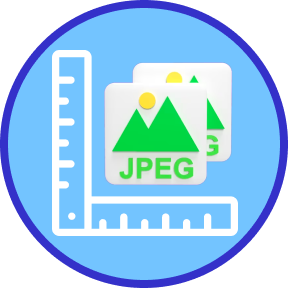Click the Choose Files button and select your JPEGs files to Reduce Sizes.
Choose options to Reduce JPEG Sizes and Click on the Size Reducer button to start the Size Reduction.
Status changes to Done; click the Download button to Download JPEGs.
Once you download the JPEGs, click on Reuse Tool or Delete the File.
1 Easy to Use - JPEG Size Reducer tool is very easy to use.
2 Quality Options - You have Quality Options to choose fromo. Highest JPEG quality when reducing sizes of images.
3 Free and Secure - We upload your files over a secure HTTPS connection. The best part is that you do not have to log in or share any personal information to use the tools. JPEG Size Reducer tool is absolutely free and at the same time website is secure; you can use the tools unlimited. When you use the tools and process the files, after the completion of the process, your files are stored in our server for 15 minutes only, and the files get deleted automatically after 15 minutes. Or, once the file is downloaded, you can delete your file yourself by clicking the delete button.
4 JPEG Size Reducer tool works on any web browser with secure HTTPS connection. So you can Reduce sizes of your JPEGs without worrying about file security and privacy.
5 Files Size - The maximum file size is 250 MB, you can process 250 MB files by uploading them in one process, but you can do it as many times as you want with all tools. The use of all tools is free and unlimited.
1 Seen on web internet browsers and smart devices everywhere, the JPEG file format is the bread and butter of everyday image file storage and display screen. Discover more about the history of JPEG images, what to use them for, and how to make the most of their compression abilities.
2 JPEG stands for Joint Photographic Specialists Group, an international organization that standardized the format during the late 1980s and early 1990s. It's the go-to format for digital images since professional photographers began snapping and saving images on digital cams and other reprographic gadgets.
3 The term "JPG" is an acronym for the Joint Photographic Professionals Group, which produced the standard in 1992. JPG was primarily responsible for the proliferation of digital images and digital pictures throughout the Web and later on social media.
1 JPEG files are perhaps the most universally identified image file format- suitable with many web browsers, software, and apps.
2 Their small file sizes enable quick transfer and quick access for viewing online. By wisely disposing of all the colors that the human eye can't select-- called lossy compression-- JPEGs keep their file size as small as possible. Compared to lossless formats like GIFs, JPEGs are dramatically smaller in size.
3 Post-processing is more accessible since white balance and saturation in JPEGs are set with the shutter's click.


